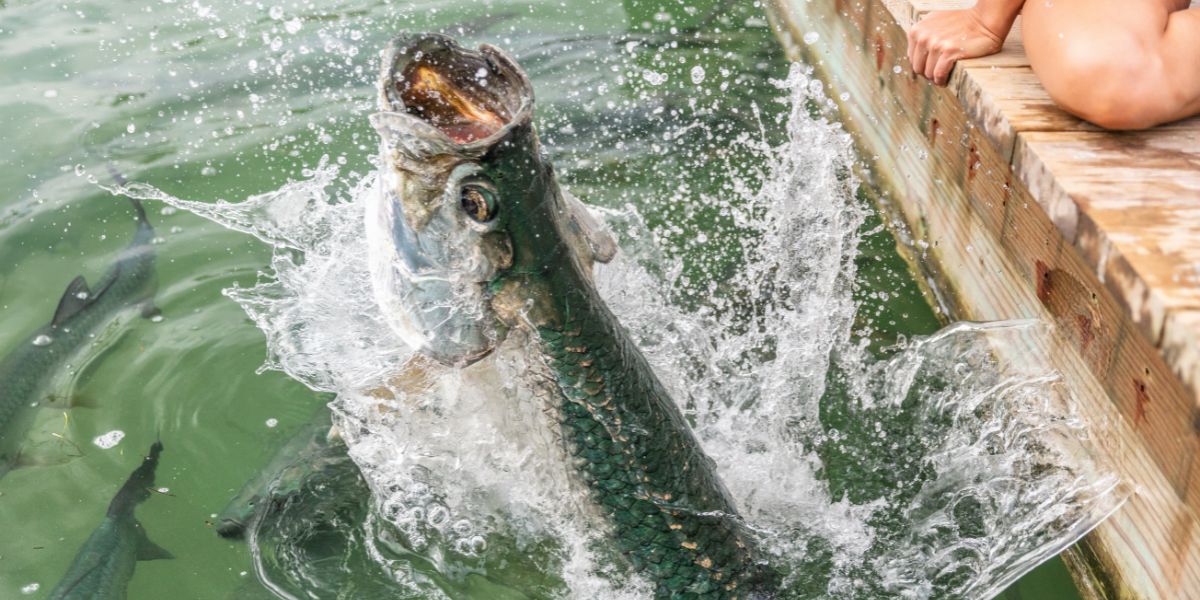
Tarpon, often referred to as the "Silver King," are one of the most exciting fish in Florida waters. Known for their acrobatic leaps and powerful runs, catching tarpon is a thrilling experience for anglers. Today we'll explore the laws surrounding tarpon fishing as well as how to catch tarpon both from a boat and from shore, with a special focus on the exciting mullet runs in Jupiter, Florida, during September and October. And, of course, where and how to feed tarpon by hand.
In Florida, there are specific regulations and guidelines governing tarpon fishing to ensure the conservation of this iconic species. Here are the key laws and regulations regarding tarpon fishing in Florida:
It's crucial for anglers to familiarize themselves with these regulations and guidelines before embarking on a tarpon fishing trip in Florida. These rules are in place to protect tarpon populations and ensure sustainable fishing practices. Always check for any updates or changes in regulations as they may evolve over time.
Fishing for Tarpon from a Boat
Shore Fishing for Tarpon
Jupiter's Mullet Runs
The mullet runs in Jupiter, Florida, during September and October are a significant event for tarpon anglers. Mullet schools migrate south along the coast, attracting hungry tarpon. To maximize your chances during this time:
-
Monitor Weather: Keep an eye on the weather as tarpon are more active when the conditions are stable.
-
Early Mornings and Dusk: Tarpon tend to be more active during the first light of the day and at dusk.
-
Patience: Tarpon fishing often requires patience, so be prepared for long waits between bites.
Feeding Tarpon by Hand
Feeding tarpon by hand can be an exhilarating experience. Here's how you can safely feed tarpon by hand:
Feeding tarpon by hand is a unique experience that allows you to get up close to these majestic creatures. Always follow any specific guidelines provided at the feeding location to ensure both your safety and the well-being of the tarpon.
Can you eat tarpon?
It is generally illegal to eat tarpon in Florida. Tarpon are protected under catch-and-release regulations in Florida, which means they are not to be harvested for consumption. The Florida Fish and Wildlife Conservation Commission (FWC) specifies that tarpon is a catch-and-release-only fishery, and there are strict regulations in place to ensure their conservation. While it is technically possible to eat tarpon, it's not common or popular. Tarpon meat is often described as having a taste that falls somewhere between salmon and tuna. Tarpon meat also contains many small, hard-to-clean bones, which can make it less desirable for consumption.
Do tarpon have teeth?
Yes, tarpon fish do have teeth, although their teeth are quite small and not designed for tearing or chewing like those of some other predatory fish. Tarpon have rows of small, densely packed teeth all over their mouth, including their jaws, tongue, skull base, vomer, palatines, and pterygoids. These teeth are known as "villiform" teeth. While tarpon have teeth, they are not considered dangerous to humans. These teeth are not sharp or designed for biting. Tarpon are primarily filter feeders and typically swallow their prey whole. So, their teeth are adapted for capturing and holding onto small prey items rather than for tearing apart larger prey.
Now You Know How to Catch Tarpon, Get Out There
Catching tarpon is not just a fishing trip; it's an adventure filled with excitement and anticipation. Whether from a boat or the shoreline, Jupiter's mullet runs offer a prime opportunity to experience the thrill of landing the Silver King.



